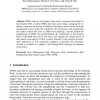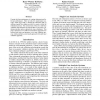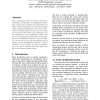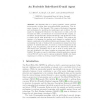RULEML
2010
Springer
14 years 1 months ago
2010
Springer
Rule bases are common in many business rule applications, clinical decision support programs, and other types of intelligent systems. As the size of the rule bases grows and the in...
ESWS
2010
Springer
14 years 4 months ago
2010
Springer
SWRL rule are increasingly being used to represent knowledge on the Semantic Web. As these SWRL rule bases grows larger, managing the resulting complexity can become a challenge. D...
FLAIRS
2003
14 years 4 months ago
2003
Current rule base maintenance is wasting refinement and inference performance. There are only few maintenance concepts, which enjoy both (1) formal rule refinement and (2) utili...
KES
2000
Springer
14 years 6 months ago
2000
Springer
Fuzzy classification rules are widely considered a well-suited representation of classification knowledge, as they allow readable and interpretable rule bases. The goal of this pa...
EPIA
2003
Springer
14 years 8 months ago
2003
Springer
The Semantic Web is a “living organism”, which combines autonomously evolving data sources/knowledge repositories. This dynamic character of the Semantic Web requires (declarat...
FUZZIEEE
2007
IEEE
14 years 9 months ago
2007
IEEE
— One of the main advantages of fuzzy modeling is the ability to yield interpretable results. Amongst these modeling methods, the OLS algorithm is a mathematically robust techniq...
RULEML
2009
Springer
14 years 9 months ago
2009
Springer
Rule bases are increasingly being used as repositories of knowledge content on the Semantic Web. As the size and complexity of these rule bases s, developers and end users need met...




